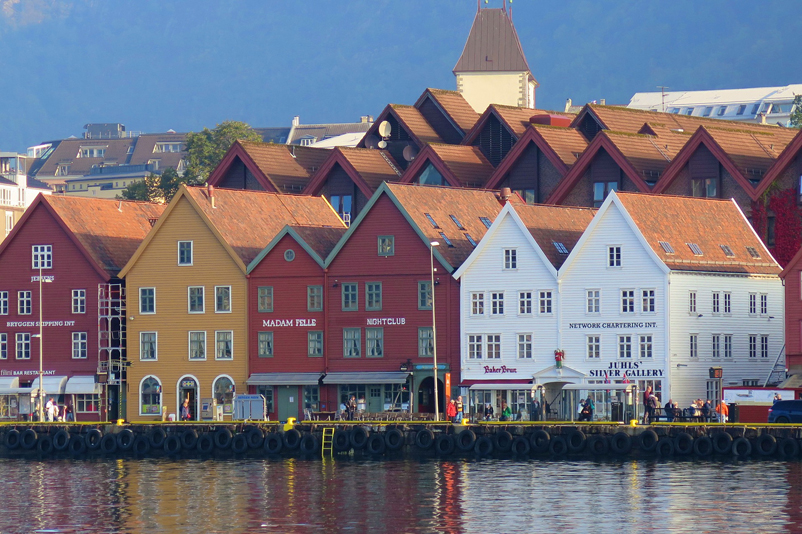Bruggen is a complex of commercial buildings located on the promenade in the center of Bergen, Norway. In 1979, Bruggen was inscribed on the UNESCO World Heritage List.
The Hanseatic Quay of Bryggen ( Bryggen Hanseatic Wharf ) is considered one of the main attractions of Bergen. The Hansa Representation in Bergen was founded in 1360 and lasted more than four centuries. In the late Middle Ages, the representative office occupied a large quarter, which was actually the center of the city of Bergen. Only men lived in this part of Bergen, they could not marry, and if a merchant was forced to a woman in Bergen, he had to pay a fine that was distributed to the poor and a large keg of beer.
The Bryggen Hanseatic Wharf is a three-story houses, decorated in different colors. The facades of many houses are decorated with wooden heads of animals or figures of people personifying various crafts and guilds. In total, there are 58 houses in the Bruggen quarter, this is a real mini-city with curved streets, wooden flooring underfoot and interesting architecture. Hanseatic Quay is a UNESCO World Heritage Site.
Today The Hanseatic Quay of Bruggen is a symbol and the main attraction of the Norwegian city of Bergen. About 900,000 tourists visit this place annually. ,in the buildings of Bruggen there are many tourist and souvenir shops, as well as restaurants, cafes and museums. Many of the buildings that survived the 1955 fire are now used as artists’ studios.
Access : Coordinates: 60.397222, 5.323056 / Location : Bergen 5003, Norway / Bryggen located at north side of the bay.
Highlights :
- Museum of the Hanseatic League : The most notable exposition is in the Museum of the Hanseatic League, founded in 1872. It was created by the Norwegian merchant Johan Olsen, who at that time owned the main chamber of the German office of Finnegarden. His main goal was to preserve for future generations the memory of the once prosperous Hanseatic League and the significance of Bergen in the history of the merchant empire. Despite the fact that none of the residents of the city believed in his idea, he was able to guarantee the support of the Swedish king, which was the first step in the foundation of the museum. Today, authentic objects are stored here that tell about the activities of representatives of the Hanseatic League.
- Fish Market : Here on the embankment, next to the old quarter, is located the famous Fish Market. Every morning they bring fresh fish, lobsters, shrimp and other gifts of the Norwegian sea. Everywhere in the fish market you can pay with plastic cards.
- The name of the unique merchant quarter, preserved from the era of the Hanseatic League, comes from the word “brygge”, which means a pier . Today, this historic site is under the reliable protection of the world famous UNESCO organization
- Church of the Virgin Mary : In the quarter there is a church of the Virgin Mary, founded back in the XII century. This is the oldest building in Bergen. Hanseatic merchants prayed here, most of them Germans. In the church you can admire the magnificent baroque altar of the 15th century, created by German craftsmen.
Activities : City Walking Tour – Bergen On Foot / Explore Bergen and surroundings / sightseeing / Architecture Photography / walk in town with its old districts
Go next : You can go to Ovregaten street, in the area of which there are a lot of antique shops / the Hansa Museum in the old house near the very center of the harbor / Bergen’s outdoor fish market

